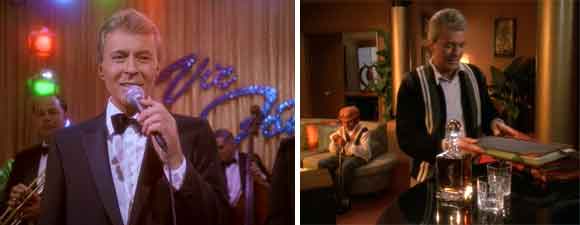Retro Review: When It Rains…
8 min readGowron takes command of the Klingon forces, Dukat is blinded, Kira trains Cardassian rebels, and Bashir discovers the cause of the Founders’ disease.
Plot Summary: Once O’Brien discovers that Klingon ships can be altered quickly to defend against the Breen energy weapons, Martok and Worf promise to hold the line, while a reluctant Kira takes Odo and Garak to train Damar’s rebellious Cardassians as resistance fighters against the Dominion. As Kira dons a Starfleet uniform to lessen Cardassian prejudice against her Bajoran identity, Odo gives Bashir a sample of his protoplasm for research on synthesizing organs for wounded soldiers. Dax tries to explain to Bashir that any romance is over between herself and Worf, but Bashir interrupts her to contact Odo with the readings he’s taken on Odo’s protoplasm to inform the shapeshifter that Odo is infected with the Founders’ disease. Starfleet refuses to send Odo’s medical records to Bashir, so the doctor asks Sisko to request them. Meanwhile, Gowron arrives on the station, gives Martok a medal and a party, then announces that he is taking command of the Klingon forces to lead a strike against the Dominion – an action that both Martok and Worf feel would be a grave mistake. On Bajor, Dukat sneaks into Winn’s study while she’s asleep to try to read the Kosst Amojan text, but the book scalds his eyes, leaving him blind. Winn has him abandoned on the streets of Bajor, assuring him that he will learn about the Bajoran people’s charity toward beggars and telling him not to return until the Pah-wraiths restore his sight. Kira advises Damar’s men to set up resistance cells and objects when Damar says they won’t attack any installation where there are Cardassians, warning that the Dominion will put token Cardassians at every one of their installations, stressing that anyone who isn’t Damar’s ally must be treated as his enemy. While Odo tries to calm Kira after Damar’s soldiers insult Bajorans, he recognizes that he has visible symptoms of the Founders’ disease. Back on the station, Bashir realizes that Starfleet has sent him fake medical records for Odo and discovers that Odo was infected with the disease nearly three years previously, when Odo visited Starfleet Medical. This means that he didn’t get the disease from the female Founder, but gave it to her, and that Section 31 must have created the pathogen with the intention of committing genocide, killing all of Odo’s people to win the war.
Analysis: I was about halfway finished writing this review when I heard the news that Leonard Nimoy had died, so everything I had been thinking has been affected by the loss of someone I admired since earliest childhood. I trust that I don’t need to tell any regular reader of TrekToday about Nimoy’s accomplishments as an actor, director, and artist in various other media, though if you came late to Star Trek, there are obituaries on the front page of this site and every other – not just those that cover entertainment news but the arts, culture, science, technology, medicine, social history. He lived well, and his biggest regret seems to have been that he was once a smoker, which cut short his activities and eventually his life. Yet it isn’t just Nimoy but his most famous character whom I have on my mind, a character for whom I share love with my parents, children, oldest friends, hundreds of acquaintances from many aspects of my life, and tens of thousands of strangers. Spock is known the world over as a symbol not just of the logic and reason he prided himself in championing, but of the difficulties of standing for rationality and intellect in the face of emotion and chaos. Nimoy’s Spock embodied contradictions, a child of two worlds who fit into neither, a man of great sensitivity who eschewed passion, the devoted friend of people who teased him when he refused to confess how much they meant to him. No one who’s seen Nimoy in “Amok Time” or “Bread and Circuses” (or “not in front of the Klingons”) can believe that Spock really has no feelings, yet he manifests the ability and willingness to put them aside, sometimes at great personal cost, placing the needs of others first for the good of individuals, society, science, politics, diplomacy, and the military organization he serves. Spock faces his own death (and resurrection) with dignity, believing his sacrifice worthwhile, though he’s perfectly capable of breaking rules and taking extreme measures to save his friends. Though he and Kirk have often been complicit in violating the Prime Directive together, Spock’s entire life is a testament to his belief in Starfleet and its values, for which he is willing to accept long alienation from his family and his own planet, to live in exile among the Romulans, even to exist as a man out of time.
“When It Rains…” is the most plot-heavy of all the complex episodes comprising Deep Space Nine‘s final arc, with every major player entangled in the deepening of a series-long arc, though the installment also manages to pack in a great deal of character development and some bitter humor. It isn’t really a surprise when Section 31 turns out to be behind the destruction of the Founders – indeed, in retrospect, that’s likely the reason for Section 31’s existence in Star Trek, the purpose of Bashir’s discovery of the organization all those months ago – but it’s a huge shock nonetheless, since it’s anathema to everything that the original Star Trek represents. I could accept a rebel group of admirals having made the decision to murder the Founders and having carried it out, much the way Admiral Leyton tried to circumvent Federation rights in the name of protecting Starfleet in the “Paradise Lost” storyline, but the invention of a section of Starfleet so secret that even the admirals don’t know it exists, given full sanction to use methods that both Klingon Intelligence and the Tal Shiar would find dishonorable, represents a schism with Gene Roddenberry’s ideals that really can’t be fixed, since Section 31 has been retconned within this series to the founding of the Federation. Everything I dislike about the Star Trek reboot movies can probably be blamed on this development, though I’m inclined to think that all the violence and shady dealings would have been justified some other way to produce a more modern, edgy action movie. I love the final DS9 arc from a dramatic perspective, and at the same time I understand why, for some lifelong Star Trek fans, it represents a break from the Star Trek they love. If Kirk and Spock had discovered Section 31, they’d have exposed and dismantled it faster than Kirk blasted apart Eminiar 7’s war machines. I find it enormously troubling that the DS9 writers couldn’t conceive of a successful free society without a Department of Homeland Security answerable to nobody committing acts worse than any terrorism on record, all in the name of protecting freedom. Even if Section 31 only gets involved when the Federation is under direct assault, since they don’t seem to have meddled in long-term plans fighting the Borg (or I doubt Picard would have remained alive) or the Maquis (which had a surprising string of successes), the fact of their existence horrifies me.
With that out of the way, there are many things to love about “When It Rains…” starting with Kira in a Starfleet uniform teaching Cardassians how to fight like Maquis and Bajoran rebels. Oh, the irony! Kira is a proud Bajoran who’d prefer to wear a uniform representing her own government, but it seems so fitting that she should wear the Starfleet pips now that she has to save the whole of the Federation with skills that, as Sisko points out, no one else uses as well as she does. When Damar wavers because his buddies don’t like listening to a Bajoran freedom fighter, Garak points out that Cardassia’s Obsidian Order would agree with Kira. The Cardassians know just how to goad Kira, reminding her that her lover – whom she now knows is dying – was once the kind of collaborator she deplores, yet we see her attachment to Odo as he tries to calm her down, just as we see Damar’s growing admiration for Kira replacing the disgust with which he always addressed her on Terok Nor. (It’s helpful to remember that Mora and the Bajorans didn’t treat Odo much better than the Cardassians treated the Bajorans, at least at first, as Bashir reminds us when he goes through Odo’s medical history.) Somehow it’s easier to watch Odo and Kira growing apart, keeping secrets to protect one another, now that it seems so apparent how this part of their story together must end. And maybe it’s terrible that I count the Pah-wraiths blinding a greedy Dukat as comic relief, but I feel nearly as gleeful as Winn when he oversteps and gets what he deserves for so many reasons. It was apparent even on first viewing of this final arc that these two must destroy one another, and the Kai is so right to force Dukat to live as a beggar among the Bajorans, though I feel a bit robbed that we never get to see him as such. Of course Winn speaks truly when she says Dukat needs to learn humility, but she’s perhaps the one person who has no business telling him that! Gowron, too, needs to learn humility, which Martok and Worf realize as soon as the Klingon leader announces his plans to take their people into battle. It’s quite apparent why Gowron wants Martok removed as the head of the Klingon military, since Martok is more popular and more visible than as a leader, but having brought about the fall of the House of Duras, you’d think Gowron would be smarter than to employ such desperate tactics to regain his own authority. So many of these characters could take a lesson from Kira, who always rises above her own issues to do the right thing for the greater good…just like Spock.







i bear Greetings from every order of Jedi or Sith, and every species in every universe.
On ti bear Greetings from every order of Jedi or Sith, and every species in every universe.On this day we drop to our knees, bow our heads and tearfully acknowledge a truly wonderful human being. Your life to the arts, dedication to the genre and your inspiration to young children such as myself will forever be the touchstone of science fiction itself.
He was truly Ambassador Spock.
And because he lived long, we will always prosper.
Thank you
I’ve been following your reviews with gusto, since I’ve also been rewatching DS9 recently, and I find your analysis and thoughts to be singularly stimulating. The Kira/Damar arc is my favourite plotline during the latter half of the 7th season, with Dukat’s ridiculous Pah-wraith plot being my least favourite, not least because it seemed so detached and unrelated from the rest of the story.
I liked the part where Kira goes off to find a cooling unit, and then comes back and tells Odo that Damar had one waiting for her – that small and almost always overlooked gesture is loaded with so much meaning. You can see that Damar’s sincerely grateful for Kira’s help and that he’s going out of his way to accommodate her and swallowing his pride, in direct contrast to his officers.
Garak, although rather sidelined in these latter episodes, is still amazing, as he, like Damar, attempts to reconcile the gap between Kira/Federation and Cardassia. One thing he and Dukat had in common was the slime factor: even in scenes where the audience knew that they were being sincere or working for the good, one couldn’t help but keep a wary, distrustful eye on them. Everything about them just screams ulterior motives. In contrast, Damar and Rusot are much blunter, without even a hint of subtlety in their characters. It’s interesting seeing how all these different dynamics play out.
—–
RIP Leonard Nimoy. You were and always will be a huge part of my life, and will continue to live on in the hearts, the memories and the stars of the future, which you embodied with such eloquence.
Pleeeeeease change the styling of this site to be dark text on light. It’s painful to read the way it is. Been begging for this for a long time. After you read one article, your vision will have white horizontal lines everywhere. It’s painful.
Dark text on light is terrible. The white isn’t paper—it’s like staring into a light bulb. All sites should be light text on dark background.
Anyway, if you have a problem with it, I believe there’s a way to set browsers to display things in your own colors, so I recommend looking into that.
Are you kidding me? There’s a reason why most sites nowadays use dark on light. That’s pretty much the standard because it’s easier to read.
Doesn’t make a difference to me.
No, it isn’t. Staring into a light bulb for hours gives people a headache. It’s only “standard” because people want to pretend it’s like ink on a book page, but it isn’t, and that’s why more and more sites are moving away from it, as are e-readers and so on.
This isn’t a book page. Deal with it.
When I read pages on my phone, I invert the colours as it’s far easier on the eyes. This means trektoday/trekbbs ends up as dark on light, which is wrong!
I largely agree with you about S31, but I also find it fascinating that both Star Trek and Babylon 5 essentially predicted the DHS and warned against what it could become, long before 9/11 happened! Remember that there WAS no Department of Homeland Security when this episode was written!